John H. Eicher
| John H. Eicher | |
|---|---|
 John Eicher as a young professor of organic chemistry at Miami University, ca. 1952. | |
| Born |
March 30, 1921 Dayton, Ohio, U.S. |
| Died | June 7, 2016 (aged 95) |
| Nationality | American |
| Education | Purdue University |
| Occupation | Professor, organic chemist, author |
| Known for | Manhattan Project, Organic chemistry professor at Miami University, historian, author, Ohio Senior Citizen of the Year 2016 |
| Notable work | Civil War High Commands |
John Harold Eicher (March 30, 1921 – June 7, 2016) was an organic chemist, philosopher of science, historian, and author. He was a Manhattan Project scientist who worked at Columbia University to develop the first atomic bomb, and taught chemistry at Miami University in Oxford, Ohio, for 37 years. Eicher was the author of several chemistry publications and, with his son David J. Eicher, was coauthor of Civil War High Commands, a significant reference book published by Stanford University Press.
In 2016, Eicher was elected by the State of Ohio to the class of 2016, Ohio Senior Citizens of the Year.,[1] an honor that in the past has recognized such Ohioans as Walter Alston, Paul Brown, Phyllis Diller, Lillian Gish, John Glenn, Paul Newman, and Lowell Thomas. He continued to teach for Miami University’s Institute for Learning and Retirement for many years, and because of this, was a teacher for 75 continuous years (in 1941 he first taught, as an assistant, a mineralogy class at Purdue University).
The product of German, Swiss, and a small amount of Delaware Native American ancestry, Eicher was born in Dayton, Ohio. As a youth, he came to know such Daytonians as Orville Wright (1871–1948) and Charles Franklin Kettering (1876–1958). Eicher’s father, Harold Ralph Eicher (1892–1968) was a sales manager with such firms as the National Cash Register Co., the Davis Sewing Machine and Bicycle Co., the Duro Pump Co., the A. B. Farquhar Co., and the Master Electric Co. His mother, Myrtle Grace (neé Wetzel) Eicher (1894–1989) was a seamstress, public school teacher, artist, china painter, piano and organ teacher, and club organizer.
Early life
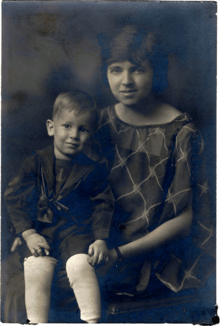
Eicher attended Fairview Elementary School, where he was class president and honorary treasurer of the City of Dayton. He was an ardent collector of postage stamps, minerals, and books, and an amateur actor, starring as Jim Hawkins in Robert Louis Stevenson’s Treasure Island in 1935 at Camp Kern, Oregonia, Ohio. Eicher organized a chemical laboratory at his home in Dayton, and practiced chemistry and all aspects of photography with a Leica camera. During the summers he traveled with his parents to all 48 states, plus trips to Alaska, Canada, Mexico, Cuba, and Central America including Panama. He particularly enjoyed the western national parks, especially Yellowstone, Grand Teton, Rocky Mountain, Crater Lake, Mount Rainier, Glacier, Yosemite, Bryce, Mesa Verde, and the Grand Canyon. He loved hiking and exploring old mines, as a follow-up to his first western trip in 1926, when he visited Pikes Peak, Colorado. Eicher studied chemistry at Fairview High School, where he was the laboratory assistant. There, he placed first in the 1938 district scholarship and fourth in Ohio.
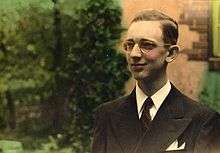
College & The Manhattan Project
At Purdue University in West Lafayette, Indiana, he continued his chemistry studies, obtaining a B.S. degree in 1942. While an undergraduate, he prepared sulfamic acid, used in the preparation of various sulfa drugs at Johns Hopkins University; he collected scrap iron for the war effort; and he was chapter president of Alpha Phi Omega, a service fraternity. He also served as laboratory assistant in mineralogy for the Purdue School of Chemical and Metallurgical Engineering.
Moving to the Ohio State University in Columbus, Eicher helped in the preparation of aviation gasoline components such as triptane, a reference compound, which was sent to the Royal Air Force during the Battle of Britain. He joined the American Chemical Society in 1943, later serving as an assistant secretary and as a councilor.
In mid-1943 Eicher joined the Manhattan Project at Columbia University in New York, working first with Willard Libby (1908–1980), Nobel Laureate in 1960; then with Harold C. Urey (1893–1981), chair of the chemistry department and 1934 Nobel Laureate; with John R. Dunning (1907–1975), dean of engineering; and with Leslie R. Groves (1896–1970), major general, commanding the Manhattan Engineer District.[2][3] There Eicher worked on the synthesis of fluorocarbons used as lubricants, as plastics such as Teflon. He then worked on pilot plant tests for the enrichment of uranium-235. Finally, Eicher spent two years along with colleague Albert L. Myerson (1919–2004) constructing and operating a gas viscosimeter used to study uranium hexafluoride at various temperatures and pressures, the data from which were used in the production of uranium isotopes at the large gaseous diffusion plant at Oak Ridge, Tennessee.[4][5][6][7][8]
Postwar Life
Returning to Purdue University in 1945 for graduate studies, Eicher taught organic technic and qualitative analysis for six years as an assistant instructor. He became a longtime chapter secretary for the Phi Lambda Upsilon national chemistry honorary, and a member of the research Society of the Sigma Xi. With colleague Alec Kelley (1923–2013), he founded a Unitarian fellowship which later became the Unitarian-Universalist Church of Lafayette, Indiana. Eicher then worked on the preparation of various nitro and oximino compounds to earn his Ph.D. in 1952.[9] One of his dissertation advisors was Herbert C. Brown (1912–2004), 1979 Nobel Laureate. Eicher often visited with his friend Linus C. Pauling (1901–1994), who won two Nobel Prizes, one for chemistry in 1954 and the Peace Prize in 1962.[10]
Eicher joined the chemistry department at Miami University in Oxford, Ohio, in 1952,[11] and he subsequently taught chemistry there for 37 years.[12] In 1953 he organized a student and faculty liberal religious club at Miami which became a Unitarian Fellowship and later evolved into the Hopedale Unitarian-Universalist Community.
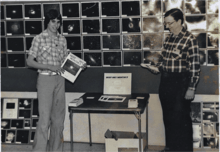
Personal life
On June 12, 1957, Eicher married Susan Ann Arne (1923–1983), a sociologist and legal secretary, in Sarasota, Florida, where the couple’s parents had retired. Their honeymoon was a month-long freighter cruise to Central and South America. They had two children, Nancy Grace Eicher (1959– ), a journalist and editor, and David John Eicher (1961– ), astronomer, historian, mineralogist, and editor of Astronomy magazine[13]
Eicher and his family spent the summer of 1966 in Washington, D.C., where he was a member of the Institute for the Philosophy of Science and Mathematics, sponsored by the National Science Foundation at American University.
Eicher and his son David made many trips to visit Civil War battlefields, mostly in the 1980s and 1990s, and together wrote Civil War High Commands (Stanford University Press, 2001).[14] Eicher collaborated with his son on a number of other Civil War book projects as well.[15][16][17]
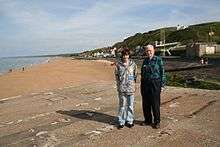
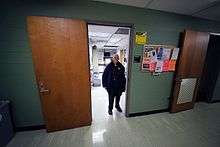
In 2008, Eicher, his son David, and his grandson Christopher (1992– ) studied World War II history during a long summer trip to France, Belgium, The Netherlands, Germany, Poland, the Czech Republic, Austria, Switzerland, and England.
References
- ↑ Kissell, Scott (May 12, 2016). "Professor Emeritus John Eicher to be inducted to Ohio Hall of Fame". Miami University of Ohio News. Miami University of Ohio. Retrieved 2016-05-15.
- ↑ "Ohio Senior Citizens Hall of Fame". www.aging.ohio.gov. Ohio Department of Aging. Retrieved 2016-05-15.
- ↑ Eicher, David. "Dr. John H. Eicher, 1921–2016 - Astronomy Magazine". Astronomy.com. Astronomy Magazine. Retrieved 2016-08-08.
- ↑ Eicher, John H.: Analysis of Mixtures of Perfluoroethylcyclohexane and Perfluoro-n-heptane, Manhattan District Engineers, SAM Laboratories, Columbia University, New York, 1944;
- ↑ Eicher, John H.: “The Viscosity of Gaseous C616,” Manhattan District Engineers, Carbide and Carbon Chemicals Corp., New York, 1945;
- ↑ Eicher, John H.: “The Determination of the Viscosity of Gaseous Uranium Hexafluoride by the Capillary Tube Method,” Manhattan District Engineers, A3825, New York, 1945;
- ↑ Myerson, Albert L., and John H. Eicher: “The Viscosity of Uranium Hexafluoride,” U.S. Atomic Energy Commission, MDDC 494, Washington, D.C., 1945;
- ↑ Eicher, John H.: “Meso-2.5-dibromohexane, J. Am. Chem. Soc., 71:2259 (1949)
- ↑ Eicher, John H.: “The Preparation of Some Cyclohexane Derivatives, and the Reaction of Alpha-halo Acids and Esters with Alkali Nitrites,” PhD. Dissertation, Purdue University, West Lafayette, Indiana, 1952.
- ↑ "In Memoriam: John H. Eicher". The Institute for Learning in Retirement: A Lifelong Learning Institute of Miami University. Miami University of Ohio. Retrieved 2016-08-08.
- ↑ WCPO-9 On Your Side, ABC affiliate in Cincinnati (2015-01-09), 93-year-old Miami University professor keeps teaching, WCPO-9 ABC News Affiliate, retrieved 2016-05-15
- ↑ Hoy, Ritter (January 8, 2015). "A life in the classroom keeps this 93-year-old professor young". Miami University of Ohio News. Miami University. Retrieved 2016-05-15.
- ↑ "Meet the Staff | Astronomy.com". Astronomy.com. Retrieved 2016-05-15.
- ↑ Press, Stanford University. "Civil War High Commands". www.sup.org. Retrieved 2016-05-10.
- ↑ Woodbury, David (2016-06-08). "of Battlefields and Bibliophiles: Dr. John H. Eicher, 1921–2016". of Battlefields and Bibliophiles. Retrieved 2016-08-08.
- ↑ "About the John H. Eicher Mineral Museum". Granite Gap John H. Eicher Mineral Museum. Granite Gap. Retrieved 2016-08-08.
- ↑ Huizing, Marie (November–December 2010). "The John H. Eicher Mineral Museum". Rocks & Minerals Magazine. Taylor & Francis. Retrieved August 8, 2016.